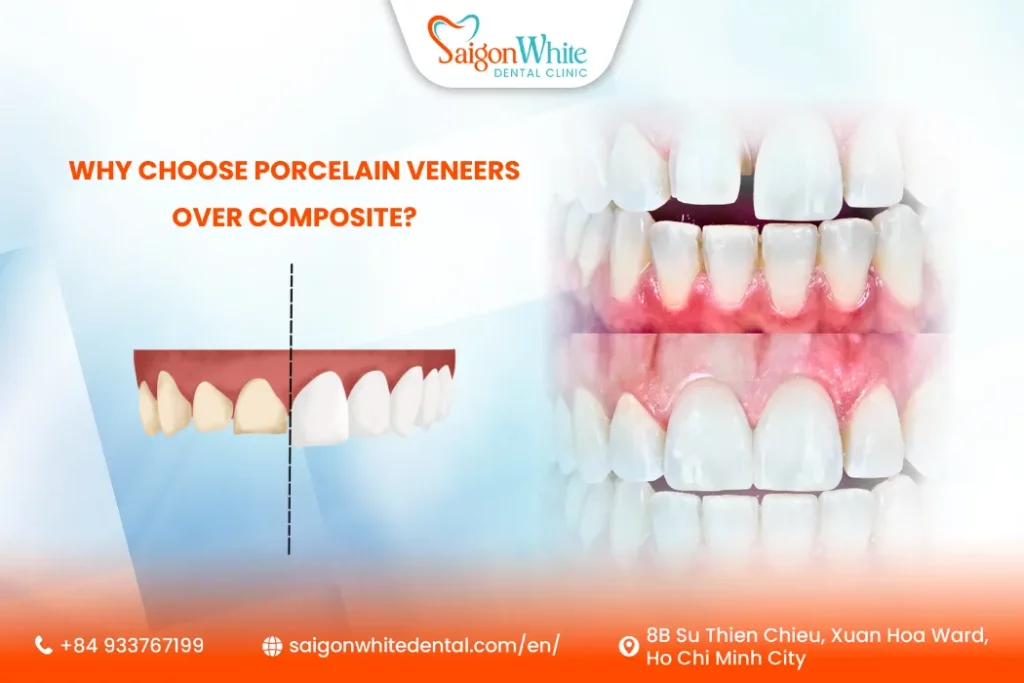If you’re dreaming of a picture-perfect smile, dental veneers are one of the most transformative solutions available in cosmetic dentistry. However, with options like porcelain veneers and composite veneers, choosing the right material for your smile makeover can be a confusing decision.
In this guide, we’ll explore the key differences between porcelain and composite veneers and explain why many patients choose porcelain veneers over composite for long-term results, durability, and aesthetics.

What Are Dental Veneers?
Dental veneers are thin, tooth-colored shells that are bonded to the front surface of teeth to improve their appearance. They are commonly used to:
- Cover discoloration or stains
- Fix chips or cracks
- Close gaps between teeth
- Improve the shape, length, or alignment of teeth
There are two main types of veneer materials used by cosmetic dentists:
- Porcelain veneers
- Composite resin veneers
Each type has its pros and cons, but both aim to enhance your smile while preserving as much of your natural tooth as possible.
Porcelain Veneers: Features and Benefits
Porcelain veneers are considered the gold standard in cosmetic dentistry for several reasons. These veneers are custom-made in a dental laboratory from high-quality ceramic materials and are designed to look and feel like natural enamel.
Benefits of Porcelain Veneers:
Exceptional Aesthetic Quality
Porcelain reflects light similarly to natural teeth. The result is a highly realistic and beautiful smile that doesn’t look artificial.
Stain Resistance
Unlike composite resin, porcelain is non-porous and resists staining from coffee, wine, tea, and smoking.
Durability and Longevity
With proper care, porcelain veneers can last 10 to 15 years or more, making them a long-term investment in your appearance.
Custom Fit and Finish
Each porcelain veneer is tailor-made to match the exact size, shape, and color of your natural teeth. This precision results in a better fit and greater comfort.
Minimally Invasive Procedure
While a small amount of enamel is typically removed, modern porcelain veneers can often be applied with minimal preparation.
Composite Veneers: Features and Limitations
Composite veneers are made of a tooth-colored resin material—the same material used for dental fillings. These veneers are sculpted directly onto your teeth during a single dental appointment.
Advantages of Composite Veneers:
- Faster Application: Often completed in one visit
- Lower Initial Cost: More budget-friendly than porcelain
- Reversible in Some Cases: Less enamel may need to be removed
Limitations of Composite Veneers:
- Less Durable: Composite material is more prone to chipping and wear
- More Prone to Stains: Resin is porous, meaning it can absorb stains over time
- Shorter Lifespan: Usually lasts 3 to 5 years, sometimes longer with exceptional care
- Less Natural Appearance: While still attractive, composite doesn’t reflect light as well as porcelain
Porcelain vs. Composite Veneers: Side-by-Side Comparison
Here’s a quick comparison of the key features:
| Feature | Porcelain Veneers | Composite Veneers |
| Aesthetic Quality | Very high – translucent, natural | Moderate – may look less natural |
| Durability | Very durable (10–15+ years) | Less durable (3–5 years) |
| Stain Resistance | Excellent – highly resistant | Fair – more prone to discoloration |
| Cost | Higher upfront investment | Lower upfront cost |
| Application Time | 2–3 visits | 1 visit |
| Repairability | Harder to repair; may need replacement | Easier to repair on the spot |
| Enamel Removal | Slightly more required | Minimal in some cases |
Why Choose Porcelain Veneers Over Composite?
Now that you understand the differences, here’s why porcelain veneers are often the preferred choice:
Superior Aesthetics
If your primary goal is a smile that looks indistinguishable from natural teeth, porcelain is the clear winner. The translucent properties of porcelain allow light to pass through the veneer and reflect off your natural teeth, creating depth and realism that composite simply can’t match.
Long-Term Investment
While porcelain veneers cost more upfront, they last two to three times longer than composite ones. Over a decade, this may actually make porcelain more cost-effective due to fewer replacements and repairs.
Stain Resistance
If you enjoy coffee, tea, red wine, or dark berries, composite veneers may begin to discolor within months. Porcelain resists these stains, helping your smile stay white and bright for years.
Ideal for Full Smile Makeovers
Patients seeking a complete transformation often opt for porcelain. Whether correcting several teeth or achieving a uniform Hollywood smile, porcelain delivers superior and consistent results.
Better for Severe Cosmetic Issues
Porcelain veneers are more effective at masking severe discoloration, cracks, or spacing issues that composite may not fully cover.
Who Should Consider Porcelain Veneers?
Porcelain veneers are one of the most popular and effective solutions in cosmetic dentistry—but they’re not for everyone. So, how do you know if porcelain veneers are right for you? Below are the ideal candidates who can benefit most from this long-lasting and highly aesthetic treatment.
People with Discolored or Stained Teeth
If teeth whitening hasn’t worked for you—or your teeth are discolored due to medication, fluorosis, or trauma—porcelain veneers can offer a dramatic improvement. Unlike composite resin, porcelain resists stains and maintains its brightness for years.
Individuals with Chipped, Cracked, or Worn Teeth
Whether due to trauma or natural wear and tear, porcelain veneers can cover minor damage and strengthen your smile. The thin ceramic shell acts like a protective layer over the front of the tooth.
People Looking to Close Gaps or Correct Minor Misalignment
Porcelain veneers can be used as a cosmetic alternative to braces for small gaps, slightly crooked teeth, or minor crowding. They won’t change your bite, but they can instantly create the appearance of a straighter, more uniform smile.
Adults Seeking a Long-Term Cosmetic Solution
If you’re looking for a smile enhancement that will last more than a few years, porcelain veneers are more durable than composite. With proper care, they can last 10–15 years or longer.
Professionals or Public Figures Who Need a Camera-Ready Smile
In industries where appearance matters—such as media, hospitality, sales, or public speaking—porcelain veneers offer a flawless, natural-looking smile that can boost confidence and presence.
People With Multiple Cosmetic Concerns
If you have several smile issues at once—like discoloration, uneven size, chips, and gaps—porcelain veneers can address them all in one procedure. It’s a comprehensive solution for a total smile makeover.
Individuals with Healthy Gums and Teeth
You must have good oral health—no active gum disease or untreated cavities—to qualify for veneers. A healthy foundation ensures that your porcelain veneers last and look their best.
People Who Don’t Mind a Permanent Commitment
Because a thin layer of enamel is typically removed, porcelain veneers are non-reversible. Ideal candidates understand this and are ready for the long-term commitment to maintaining them..
Things to Consider Before Getting Veneers
Before committing to dental veneers—especially porcelain—it’s essential to weigh several important factors. Veneers are a powerful tool in cosmetic dentistry, but they aren’t suitable for everyone. Understanding the implications will help you make an informed, confident decision.
Veneers Are a Permanent Procedure
Porcelain veneers typically require the removal of a small layer of enamel from the tooth’s surface to ensure a proper fit.
This process is irreversible, meaning once you get veneers, you’ll need to maintain or replace them for life.
Cost and Long-Term Investment
Porcelain veneers are more expensive than composite veneers, often ranging between $600 $2,000 per tooth, depending on your location and dental provider.
While the initial cost may seem high, their durability and longevity often make them more cost-effective in the long run.
Your Current Oral Health
Veneers are not a solution for existing dental issues like cavities, gum disease, or tooth decay. These conditions must be treated beforehand to ensure your veneers last and your oral health stays intact.
Habitual Behavior and Lifestyle
Do you grind your teeth at night (bruxism)? Do you bite your nails or use your teeth to open packages? These habits can compromise the integrity of veneers, especially composite ones. Porcelain is strong, but even it can crack under constant pressure.
Maintenance and Aftercare
While veneers are low-maintenance, they still require excellent oral hygiene. Brushing, flossing, and regular dental check-ups are a must. Additionally, while porcelain is stain-resistant, your surrounding natural teeth are not, which can cause uneven coloring over time.
Realistic Expectations
Veneers can dramatically enhance your smile, but they aren’t miracle workers. They won’t fix severely misaligned bites or replace missing teeth. It’s important to understand the limits of what veneers can achieve.
Temporary Sensitivity
Some patients experience sensitivity to hot or cold foods shortly after veneer placement. This typically fades within a few days, but it’s good to be prepared and follow post-procedure care instructions.
Lifespan and Future Replacement
Porcelain veneers last 10–15 years, while composite veneers may need replacing after just 3–5 years. Over time, you’ll need to budget for repairs or a full replacement to maintain your smile.
Real Patient Stories: Porcelain Veneer Transformations
Patients who’ve chosen porcelain veneers often describe their experience as life-changing:
“I was always self-conscious about my stained teeth. After getting porcelain veneers, I can’t stop smiling. They look so natural that nobody even knows I had work done!” — Jessica, 34
“I had composite veneers for 5 years, but they started chipping and staining. I recently upgraded to porcelain veneers, and the difference is incredible. Wish I had done this sooner!” — Adam, 42
Before-and-after photos further demonstrate the dramatic improvements porcelain veneers offer—whether it’s closing gaps, reshaping teeth, or delivering a completely new smile.
What’s the Procedure Like for Porcelain Veneers?
Here’s a quick overview of what to expect:
- Consultation
You’ll discuss your goals and review mock-ups or digital smile designs with your dentist. - Tooth Preparation
A small amount of enamel is removed to make room for the veneer. - Impressions and Temporary Veneers
Impressions are sent to a lab. Temporary veneers are placed to protect your teeth. - Final Placement
When the custom veneers return, they are bonded to your teeth using a strong adhesive. Your smile is instantly transformed.
Are Porcelain Veneers Worth the Price?
Yes—if your priorities include natural beauty, durability, and long-term satisfaction, porcelain veneers are well worth the investment.
Unlike composite, which may stain or chip within a few years, porcelain maintains its brilliance and structure for over a decade. And for many patients, the confidence boost and improved self-esteem are priceless.
Conclusion: Porcelain Veneers or Composite? Choose Quality That Lasts
Both porcelain and composite veneers have their place in modern dentistry. But for patients who seek long-term value, superior aesthetics, and high performance, porcelain veneers are the clear choice.
If you’re considering a smile makeover, consult with a qualified cosmetic dentist who can evaluate your needs, lifestyle, and goals to recommend the right veneer option.
Ready for a Radiant Smile?
Book your consultation today at Saigon White Dental and discover how porcelain veneers can transform your look — beautifully and permanently.

 Telegram
Telegram